The Penitent King David from a Book of Hours
November 27, 2019 in Manuscript Studies
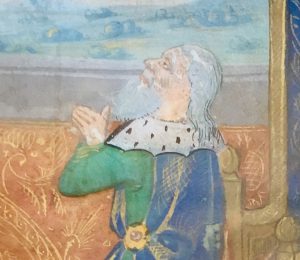
Detached Manuscript Leaf on Vellum
with Framed Illustration and Text
King David with Crown and Lyre
at the Opening of Psalm 6 or 37 (38) in Latin from a Book of Hours
At least circa 125 × 160 mm (as framed and matted)
Rouen, circa 1480–90
or Western France circa 1470
J. S. Wagner Collection
[Posted on 27 November 2019, with updates, for which we thank our Honorary Trustee, James H. Marrow, and our Honorary Invited Associate, Gregory T. Clark.]
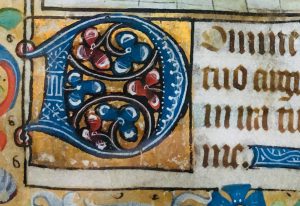
J. S. Wagner Collection, Detached Leaf. Opening of Psalm 6 or 37 (38) in 4 lines.
Continuing our exploration of manuscript fragments in our Blog on Manuscript Studies, we welcome a new addition to the quest. See the Contents List for this blog, mostly written by Mildred Budny, for the series of revelations.
From the collection of J. S. Wagner, we offer images from a detached leaf on Vellum in Latin apparently from a Book of Hours. Some of our earlier posts have addressed Books of Hours. See our Contents List.
At present, the Wagner leaf is contained within a frame, so that only one side is visible. It might be the recto or verso of the leaf. If the former, the reader and beholder would have to turn the page in order to advance to the sequential text. If the latter, the facing page would have manifested it at a glance.
As it stands, the page presents the illustrated opening of one of the Penitential Psalms in Latin in the Vulgate Version from a luxurious Book of Hours. The ambition of its production is manifested by the script, illustration, and decoration, as well as the use of gold and other pigments. The quality of the execution, however, exhibits some haste in places.
The set of Penitential Psalms comprise Psalms 6, 31, 37, 50, 101, 129, and 142 (that is, 6, 32, 38, 51, 102, 130, and 143 in the Hebrew numbering).
The opening of text upon the page corresponds to Verse 1 of both Psalm 6 and Psalm 37 (38). See below for those options. That is, at present, given the state of the leaf, we don’t know which.
Now contained within a frame behind glass, this page might represent the recto or the verso of the leaf. For example, if the other side (if the verso) continues the text, it would establish which Psalm is represented. If the other side (if the recto) is the formerly previous text, then it might designate some Psalm or otherwise in the liturgical sequence.
Needless to say, problems aplenty can arise when a leaf is excised and dispersed without accompanying information. (Examples and their challenges appear in many of our blogposts. See our Contents List.)
Call it detective work, and you would be right on track. The good thing is that sharing of images and information might yield increased knowledge. We thank the owner for sharing his images with us, and we thank our friends, colleagues, Associates, and Trustees for helping to discover more information about the center from which this leaf came.
Herewith some clues.
The Page
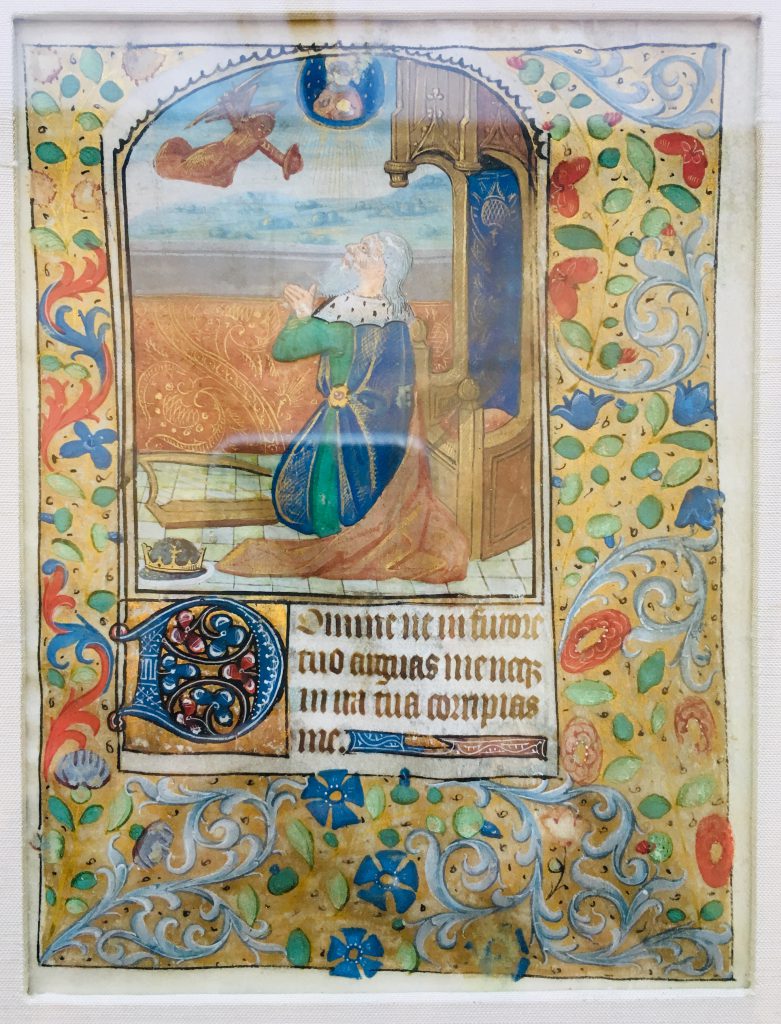
On the back of the frame, an inscription written in ballpoint pen identifies the leaf as “1490 Netherland, King David and Lyre”. So far I haven’t seen an image of that inscription. Perhaps its style of script might identify a specific vendor known through other sales. That might aid an exploration of the travels of the leaf across geography and collections.
The Illustration

J. S. Wagner Collection. Manuscript Leaf with Illustration of King David.
The illustration, contained within an arcade, depicts the white-haired, bearded king kneeling, facing left with his turned in profile, and raising his hands clasped in prayer. At the left on the tiled floor beside him lie his discarded or attendant attributes of a crown-plus-helmet and a lyre, while his elaborate niche-like throne stands empty at the right.
A bronze-like flying angel with flowing tunic, raised sword, and ready shield hovers at the upper left with menacing pose. One might think that the angel represents a sculptural manifestation. At the center top appears a round mandorla which contains the half-length frontal and haloed figure of the Deity holding a round orb, equaling the cosmos. Below the mandorla stream golden rays of light over the distant landscape populated with puffy cloud-like rounded hills.

J. S. Wagner Collection. King David as Penitent.
The Penitent Subject
Such scenes, with the penitent King David, laying down his crown and lyre, can be found in various Books of Hours, Flemish and French included. A few:
To say the least: King David as Penitent appears in very many images.
The Text and Decoration
The scene stands within a full-page foliate border which also embraces the short text-block below. The foliage comprises 7 segments of undulating, scrolling, and branching stems placed variously within the full-page rectangular frame. Strewn petals and flowers appear between those segments.
The text presents the opening of Verse 1 of either Psalm 6 or Psalm 37 (38) among the Penitential Psalms. This shared opening states: Domine ne in furore tuo arguas me (“O Lord, rebuke me not in thy wrath”).
On “our” page, the text presents a 4-line inset initial, enclosed within a sub-rectangular gold frame, alongside 4 lines of text in angular Gothic script, concluding with a sub-rectangular line-filler with schematic geometric-and-foliate ornament. The decorated initial includes graceful foliate and geometric ornament. Its branching, scrolling stems end in trefoil terminals.
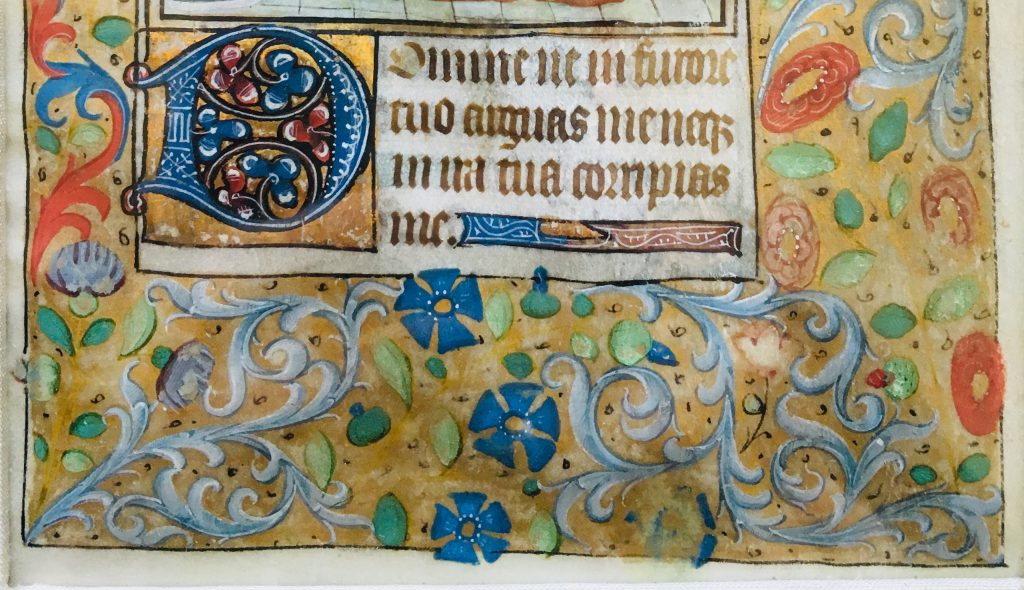
J. S. Wagner Collection. Detached Manuscript Detached Leaf with the Opening in Latin of the Penitent Psalm 6 or 37 (38).
The following text should decide which Psalm.
That text would stand on the other side of the leaf, if it is a recto, or on the formerly facing page of the next leaf, if it is a verso. In both Psalms 6 and 37 (38), it should continue with the words neque in ira tua corripias me (“neither chasten me in thy hot displeasure”), completing Verse 1.
Thereafter they diverge in their readings. Their Verse 2 open differently thus:
- Psalm 6: miserere mei Domine quoniam infirmus sum (“Have mercy upon me O Lord; for I am weak”)
- Psalm 37 (38): quoniam sagittae tuae infixae sunt mihi (“For thine arrows stick fast in me”)
The Original Manuscript and Its Place of Origin
On the page, such signs as the roughly-drawn rippled line at the top of the arcade and the partly askew boundary lines of various elements betray an unsteady, unprofessional, or hasty hand. They mix, perhaps disconcertingly, with the skilled elements — image, decoration, and text included — that combine with them upon the page. The origin of some or all elements of this illustrated leaf might be identifiable, now that it is brought to wider attention.
We thank the owner for bringing this leaf to our attention and permitting us to publish it here. We thank our colleagues for their expert comments: James Marrow, Gregory Clark, Barbara Shailor, and Consulo Deutschke. Together, Barbara Shailor and Consuelo Deutschke observe from its stylistic features that the illustrated leaf belongs to a manuscript made in Northwest France circa 1480.
James Marrow, moreover, identifies it as the work of Rouen in Normandy in the 1480s. With his permission, we can report that identification. In particular, he points to The Playfair Hours, at the Victoria and Albert Museum, as an essential reference point.
Manuscript Production at Rouen in the 1480s
The Playfair Hours in the Victoria and Albert Museum is a Book of Hours written and illuminated in Rouen, with readings designed for use in the British Isles. Moreover it names some Scottish saints in its liturgical Kalendar. Those features demonstrate production for an owner in the British Isles, and particularly Scottish. The Kalendar opens with the beginning of January, seen here, within an elaborate foliate frame which embraces a part-page illustration as well as the single column of text in multiple colors, gold pigment included.
This sample page shows not only a part-page illustration, here with a domestic scene, but also the foliate border and a specimen of its lettre båtarde, the stately grade of script chosen for the main text. Notable too, among other features, is the competent accomplishment of the foliate and floral decoration displayed within the border of the page.

London, Victoria and Albert Museum, The Playfair Hours, Folio 1r. Rouen, circa 1480s.
For a detailed study of that manuscript, see Rowan Watson, Playfair Hours: A Late Fifteenth-Century Illuminated Manuscript from Rouen (London: Victoria and Albert Museum, 1984). The study examines, for example, the book-trade in Rouen as it encountered the onset and challenge of printing, against the aims to continue manuscript production as a viable occupation, albeit with canny adaptations.
The Edinburgh manuscript is described in some detail in Catherine Borland, Catalogue of the Western Mediæval Manuscripts in Edinburgh University Library (Edinburgh, 1912), pages 73–100. Images from some of the pages in the manuscript appear online, including January in its Calendar.
Its illustration of the Penitent King David on folio 80 recto for the first of the Penitential Psalms (Watson’s colour Plate XXI) shows various elements known to us in the Wagner Leaf, including the discarded lyre and crown + helmet (here with a touch of ermine at its rim), the niche-like throne, the tapestry dias or wall between the penitent and the distant background (in this case a cityscape), and the deity in a mandorla at the top of the scene. However, other differences set this rendition apart, as with the presence of the admonishing prophet Nathan and the multiple scenes from David’s life in place of foliate decoration within the border.
Interesting that both these opening pages, in the Edinburgh case and the Wagner Leaf present the text of the Psalm in exactly the same span: Domine ne in furore tuo arguas me. The preservation of the Playfair Hours as an integral unit permits the identity of this page to be known as the first of the Penitential Psalms, namely Psalm 6.
Further shared features with the Wagner Leaf include the freehand, uneven rippled arched line at the top of a low arch. Examples appear in the Playfair Hours on multiple pages (Watson’s colour Plates XII–XX), in both illustrations on each page.
The same unsteady rippled arched line also appears in a related manuscript, likewise from Rouen and likewise made for the British market. Rowan Watson’s Figure 14, on page 46, includes 2 images in the lower half with such similar lines. They belong to Edinburgh University Library, MS 43, folios 1 recto and 12 recto, from the Calendar illustrations for January and December. See also page Rowan Watson’s page 119.
Somewhat strange, don’t you think, that such an unsteady feature would be permitted so plentifully in manuscripts of skilled production in a book trade having confident expectations?
Also a Candidate for the Origin: Western France circa 1470
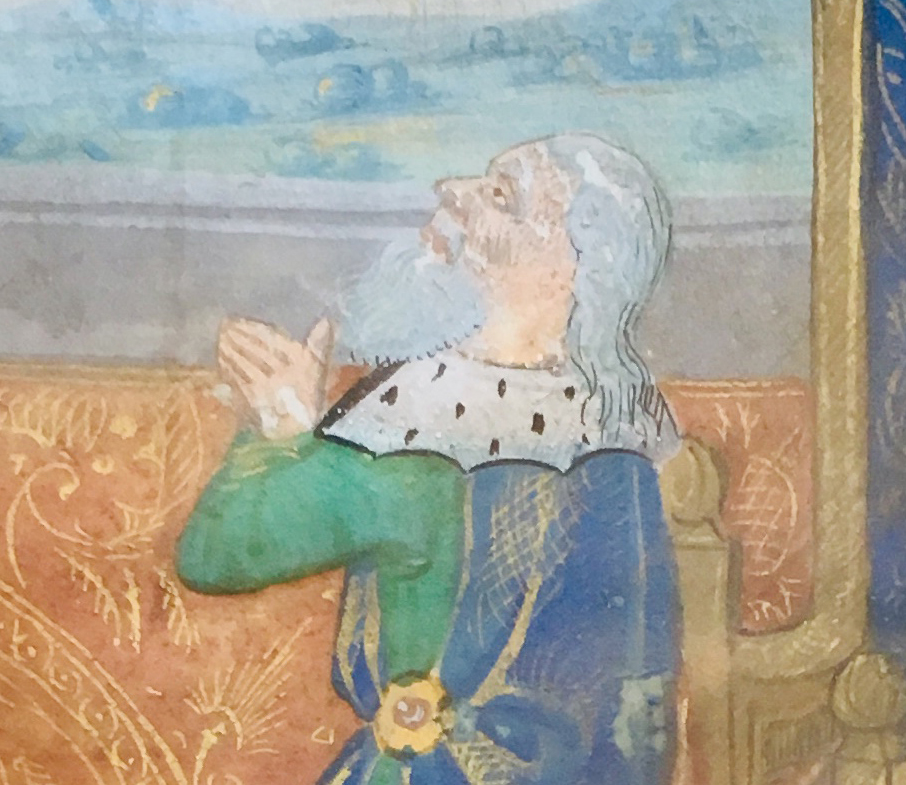
J. S. Wagner Collection. Detached Manuscript Leaf with the Opening in Latin of the Penitent Psalm 4 or Psalm 37 (38) and its Illustration of King David.
The Gulbenkian illustration:
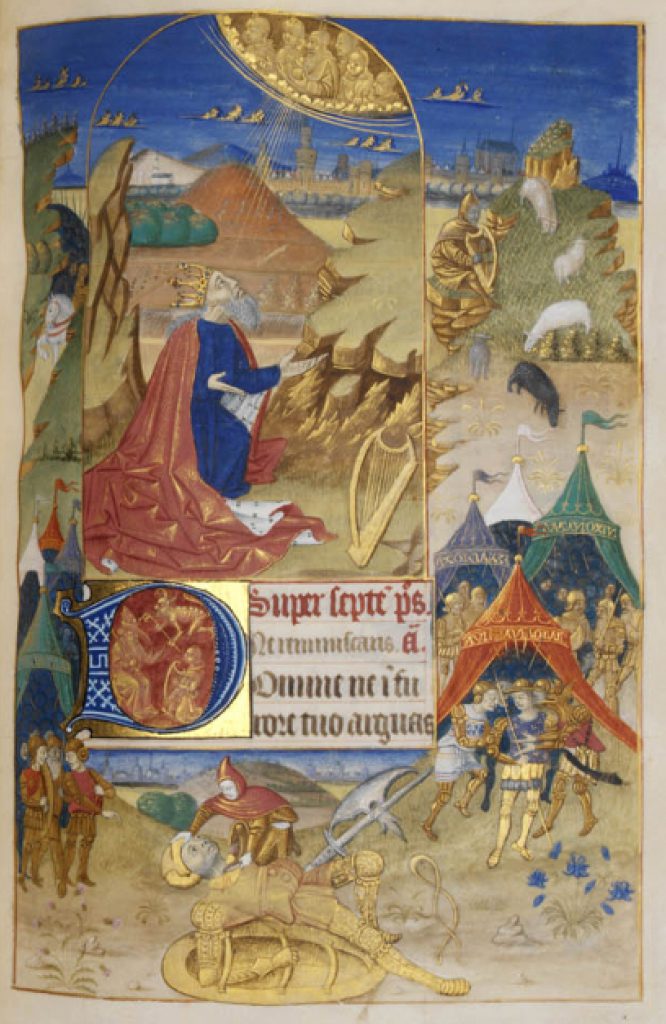
Lisbon, Museu Calouste Gulbenkian, MS LA135, folio 97r. Courtesy of the Calouste Gulbenkian Foundation, Lisbon / Photo: Catarina Gomes Ferreira.
In this case, the scene of the Penitent David stands within an arched field atop the opening of the Psalm. Both fields fit within a full-page rectangular panelled frame containing multiple scenes from David’s life. The penitent king kneels within a craggy landscape, looks up toward the right to a heavenly crowd within an almond-shaped mandorla, and lifts his arms with upturned palms in a beseeching gesture. He retains his crown, while the lyre stands upright to the right.
The first 2 lines of the Psalm (up to tuo arguas) follow 2 introductory lines of text: a single-line rubricated opening title Super septem psalmi and the cue for the A[ntiphon] beginning Ne reminiscaris (“Remember not . . . “). By these introductions, the Psalm evidently comprises the first in the series of the Septem Psalmi Paenitentiales. That is, Psalm 6.
A Lost Manuscript
We do not yet know if there survive any other siblings from the former manuscript containing the Wagner Leaf. This gap means that we have little chance yet of recognizing the other parts of its textual and illustrative components as a Book of Hours. Those parts might, for example, aid in the recognition of which liturgical use was the intention of its text, and which saints would be preferred in the celebration of the owner’s (or owners’) liturgical year.
We look forward to more information. For help with these explorations, we thank the owner of the leaf, Barbara Shailor, Consuelo Deutschke, James Marrow, Gregory Clark, and Senhor João Carvalho Dias, Coordenador de Curadoria, Museu Calouste Gulbenkian.
Help Wanted
Do you know of other representatives from this dispersed manuscript or any other products by the scribe, artist, or artistic center responsible for the Penitent David leaf?
Please let us know. We welcome suggestions and feedback. Contact Us and visit our Facebook Page.

*****
